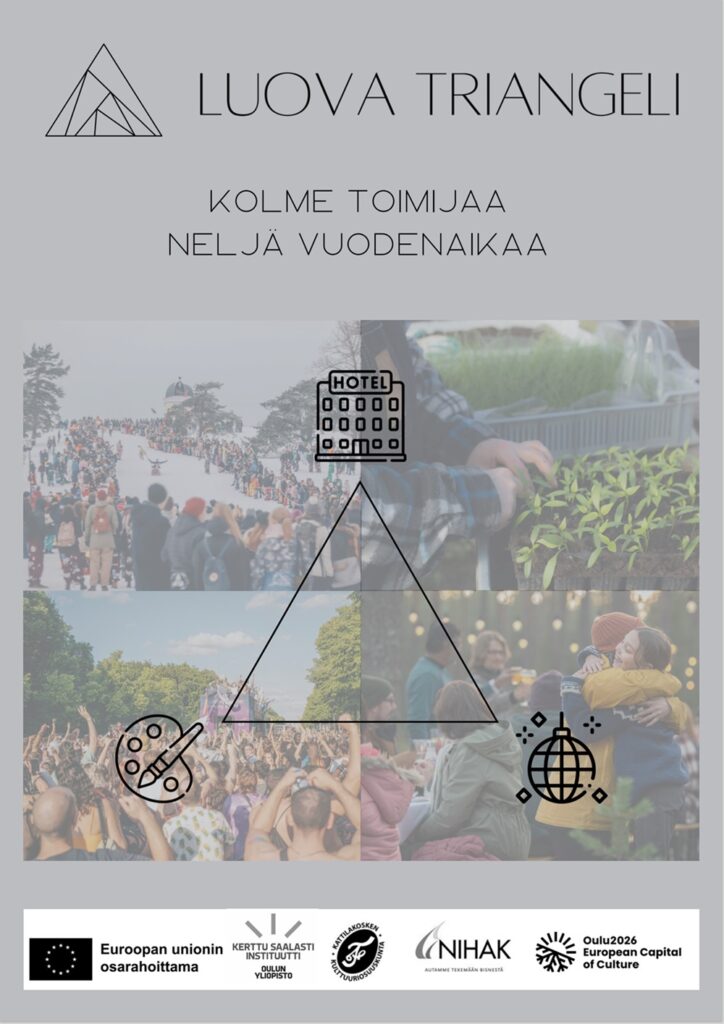
Mitä käytännössä teemme?
- Yhdistämme luovien alojen yrittäjät ja ammatinharjoittajat, ohjelma- ja tapahtumapalveluiden sekä matkailupalveluiden tuottajat.
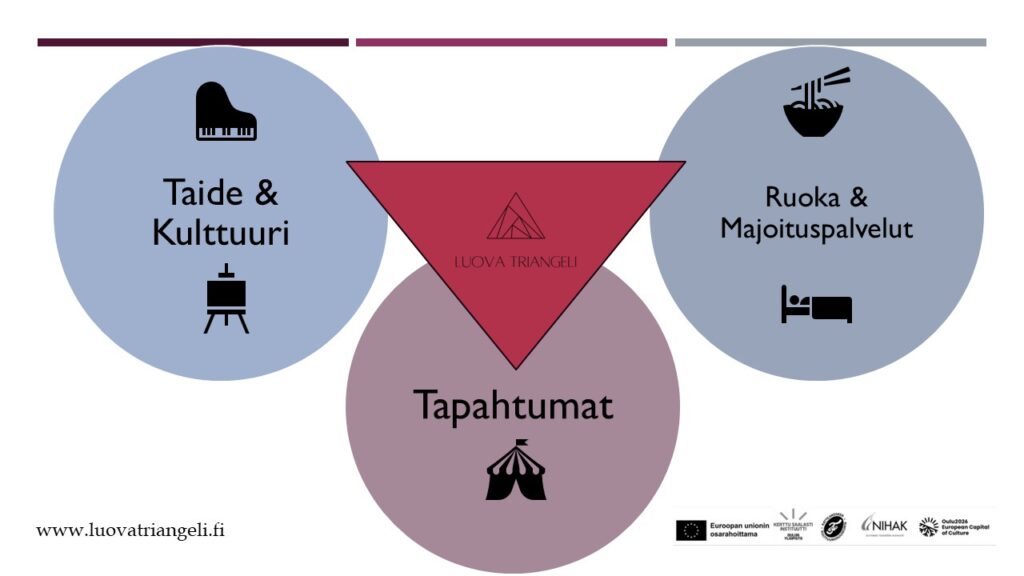
2. Järjestämme avoimia koulutuksia, joiden avulla parannamme toimijoiden kaupallistamis- ja liiketoimintaosaamista.

3. Autamme löytämään keinoja pidentää Pohjois-Pohjanmaan matkailusesonkia tarjoamalla kulttuurielämyksiä matkailukohteiden yhteydessä.
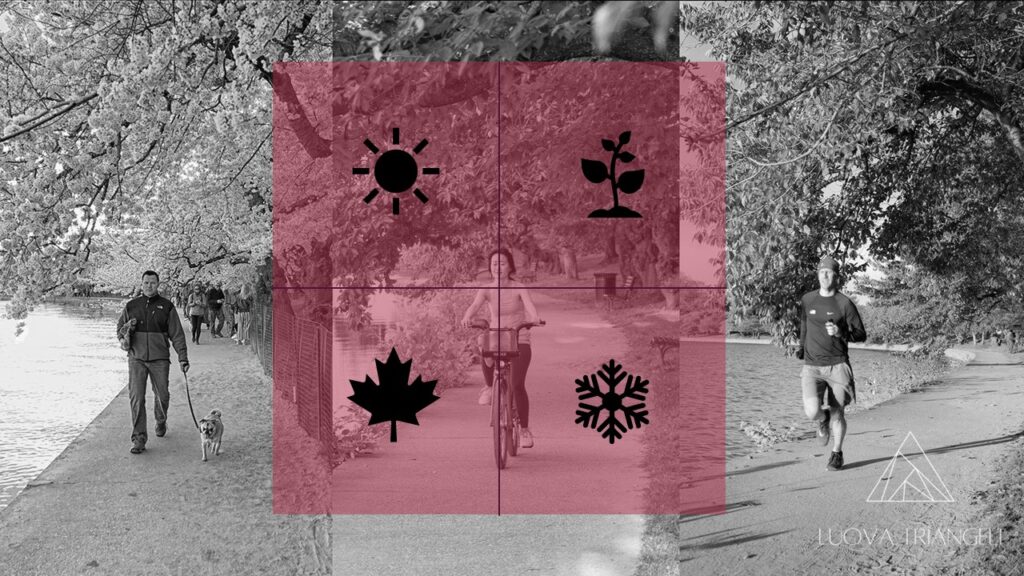
4. Kehitämme Pohjois-Pohjanmaan luonto- ja kulttuurikohteiden yhteisviestintää.
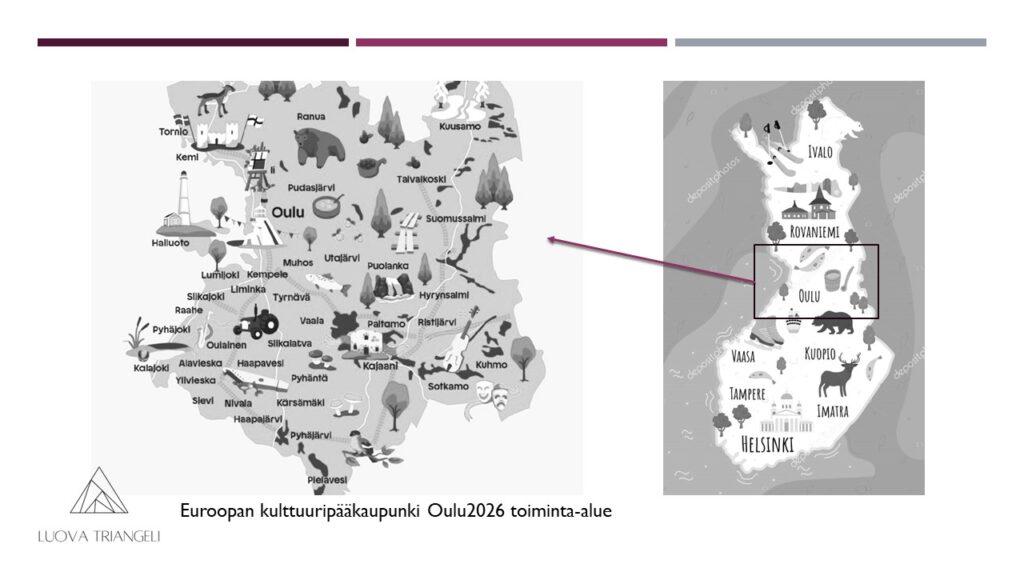
Hankkeen työpaketit
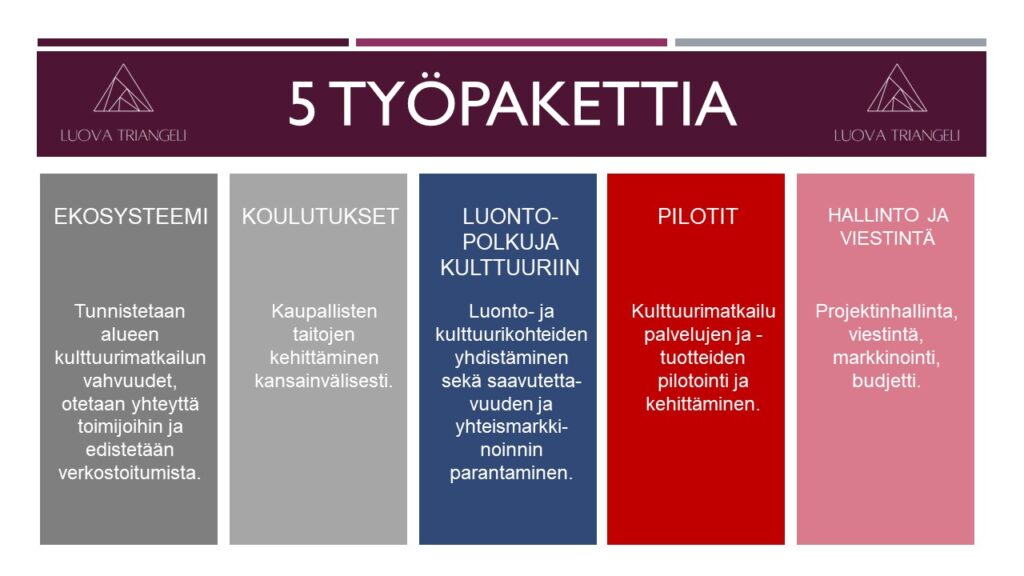
Työpaketti 1 keskittyy kulttuurin, ohjelma- ja tapahtumapalveluiden sekä matkailupalveluiden ekosysteemin kehittämiseen liiketoimintaympäristönä. Tavoitteena on tunnistaa alueen kulttuurimatkailun vahvuudet, kontaktoida toimijoita ja edistää verkostoitumista eri kuntien välillä. Tämä muutos voi näkyä hankkeen kohderyhmässä, kuten taiteilijoissa ja kulttuurin tuottajissa, yhteistyön mahdollisuuksina ja liiketoiminnan kehittymisenä. Asiakas- ja kuluttajarajapinnan ymmärtäminen auttaa ajoittamaan palveluita paremmin asiakkaiden tarpeiden mukaisesti.
Työpaketissa 2 pyritään kehittämään Luova Triangelin toimijoiden osaamista kaupallisesti, liiketoiminnallisesti ja kansainvälisesti. Koulutuksilla ja työpajoilla tuetaan taiteellisen alan toimijoiden pyrkimystä ammattimaiseen taiteilijan työhön. Muutos tässä voi näkyä osaamisen parantumisena, verkosto-osaamisen lisääntymisenä ja mahdollisuutena päätoimiseen taiteilijan uraan.
Työpaketti 3 keskittyy luontokohteiden ja kulttuurikohteiden yhdistämiseen sekä saavutettavuuden ja yhteismarkkinoinnin parantamiseen. Tämä muutos voi näkyä alueen asukkaille ja kansallisille sekä kansainvälisille matkailijoille entistä houkuttelevampana mahdollisuutena tutustua alueen luontoon ja kulttuuriin. Harvaan asuttujen alueiden työllisyyden paraneminen voi olla yksi konkreettinen vaikutus.
Työpaketti 4 keskittyy kulttuurimatkailupalveluiden ja -tuotteiden pilotointiin ja kehittämiseen. Muutos voi näkyä uusina elämyksellisinä matkailupalveluina, kulttuurin ja luonnon yhdistämisenä sekä sesonkiaikojen pidentämisenä. Tämä voi houkutella matkailijoita alueelle myös perinteisten sesonkiaikojen ulkopuolella ja lisätä alueen taloudellista toimeliaisuutta.
Hankkeen tarve ja tausta
Luova Triangeli -hanke vastaa maaseutualueiden toimijoiden tarpeeseen verkostoitua ja lisätä yhteistyötä sekä kehittää liiketoimintaa ja tunnistaa olemassa oleva liiketoimintapotentiaali. Hanke tarvitaan, jotta alueen kulttuurimatkailukohteita voidaan nostaa esille kansallisesti ja kansainvälisesti sekä kehittää niiden saavutettavuutta ja yhteismarkkinointia.

Hankkeen kohderyhmät
Hankkeen varsinaisina kohderyhminä ovat ensisijaisesti yritykset ja muut toimijat (yhdistykset, säätiöt) kulttuuri- ja luovilta aloilta (esim. taiteilijat ja ohjelmapalveluyritykset) sekä matkailu- ja ravintolapalvelualoilta sekä vapaa-ajan toimialalta. Lisäksi hankkeen kohderyhmään kuuluvat alueen kunnat ja kehittäjäorganisaatiot sekä paikalliskulttuurin asiantuntijat, kuten
kotiseutuyhdistykset.
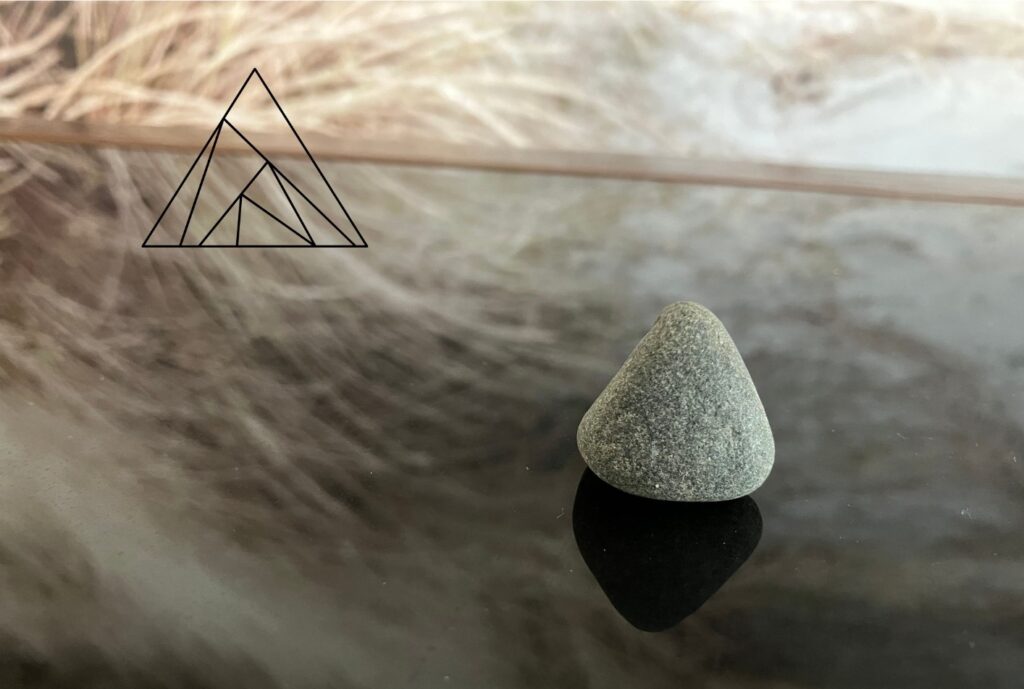
Hankkeen toivottavat vaikutukset
1) Liiketoiminnan monipuolistuminen: Hankkeen avulla pyritään tukemaan eri toimialoilla toimivien toimijoiden verkostoitumista, mikä voi johtaa uusien liiketoimintamahdollisuuksien syntymiseen. Tämä voi kattaa esimerkiksi kulttuurimatkailuun liittyvien palvelujen laajentamisen, yhteistyön taiteilijoiden ja muiden toimijoiden kanssa sekä uusien sesonkien kehittämisen.
2) Osaamisen kehittyminen: Työpaketissa 2 keskitytään Luova Triangelin toimijoiden osaamisen kehittämiseen. Tämä voi tuoda suoran hyödyn taiteilijoille, auttaen heitä paremmin ymmärtämään liiketoimintaa ja mahdollistaa päätoimisen ammattimaisen taiteilijana työskentelyn. Osaamisen lisääntyminen voi myös parantaa taiteilijoiden mahdollisuuksia työllistyä ja ansaita taiteellisesta työstään.
3) Kulttuurikohteiden ja -tapahtumien saavutettavuuden parantaminen: Työpaketissa 3 keskitytään saavutettavuuden ja yhteismarkkinoinnin kehittämiseen myös kansainvälisestä näkökulmasta. Tämä voi johtaa siihen, että alueen kulttuurikohteet ja -tapahtumat tulevat paremmin saataville ja tunnetuiksi. Tämä taas voi houkutella enemmän matkailijoita alueelle ja lisätä paikallisten yritysten liiketoimintaa.
4) Kulttuurimatkailupalveluiden ja -tuotteiden pilotointi: Työpaketissa 4 pilotoidaan uusia kulttuurimatkailupalveluja ja -tuotteita. Tämä voi tuoda suoran hyödyn niille, jotka osallistuvat näihin palveluihin ja tuotteisiin, kuten matkailijoille ja paikallisille asukkaille. Näiden palvelujen avulla voi tarjota uusia elämyksiä ja aktiviteetteja alueella.
Mahdollisia myöhemmin ilmeneviä vaikutuksia ovat:
5) Alueellinen taloudellinen kasvu: Kestävän kehityksen mukaisen liiketoiminnan lisääntyminen voi johtaa alueelliseen taloudelliseen kasvuun. Uusien yritysten perustaminen ja olemassa olevien yritysten vahvistuminen voivat lisätä työllisyyttä ja paikallisen talouden elinvoimaisuutta.
6) Kulttuurimatkailun kasvu: Parantunut kulttuurimatkailupalvelujen ja -tuotteiden saavutettavuus ja laatu voivat houkutella enemmän matkailijoita alueelle. Tämä voi johtaa kulttuurimatkailun kasvuun, mikä puolestaan voi tukea paikallisia yrityksiä ja lisätä alueen tunnettavuutta matkailukohteena.
7) Kulttuurin ja taiteen vahvempi rooli alueella: Osaamisen kehittäminen taiteellisilla aloilla voi tuoda lisää kulttuurista ja taiteellista sisältöä alueelle. Tämä voi vahvistaa alueen kulttuuri-identiteettiä ja lisätä paikallista ylpeyttä omasta kulttuurista.
8) Kestävän matkailun edistäminen: Hankkeessa korostetaan kestävän matkailun periaatteiden noudattamista. Tämä voi edistää ympäristövastuullisten matkailijoiden houkuttelemista alueelle ja lisätä tietoisuutta kestävistä matkailukäytännöistä.
9) Yhteistyön ja verkostoitumisen vahvistuminen: Hankkeen aikana luotu verkosto ja yhteistyömallit voivat jatkua ja vahvistua myös hankkeen päättymisen jälkeen. Tämä voi luoda pitkäaikaisia mahdollisuuksia uusille projekteille ja aloitteille.
Hankkeen päätoteuttaja: Oulun yliopiston Kerttu Saalasti Instituutti
Hankkeen osatoteuttajat: Oulun kulttuurisäätiö rs., Kattilakosken kulttuuriosuuskunta ja Nivala-Haapajärven seutu NIHAK ry

______________________________________________________________________________________________________________________________________
Need and background of the project
The Creative Triangle project responds to the need of actors in rural areas to network and to increase
cooperation and to develop business and identify existing business potential. The project
is needed to raise the profile of cultural tourism destinations in the region at national level and
nationally and internationally and to develop their accessibility and co-marketing.
In particular, the following development needs have emerged during the preparation of the project:
- Developing the business skills of actors in the region
- Closer cooperation between cultural and tourism operators in the region to develop new cultural tourism services
the need to create cultural services that are part of the region’s
products sold by tourism entrepreneurs - The region has built on the work of previous projects, e.g. the Kattilakoski
residency activities have developed and the Pyhäjärvi residency activities have started. This work will be
will be continued. - Identification of cultural tourism destinations in the region, development of a co-marketing model for them and
improving their accessibility. - The region’s internationalisation potential is untapped, and this requires cooperation, joint
resources and skills development. - There is a need for practical measures, implemented in cooperation between operators from different sectors
business development experiments.
Target group of the project
The actual target groups of the project are primarily businesses and other actors (associations,
foundations) in the cultural and creative sectors (e.g. artists and programme service providers) and in the tourism and
catering and leisure sectors. The project also targets
municipalities and development organisations in the region and local culture experts, such as
local heritage associations.
The need for the Creative Triangle project is highlighted for several reasons. The sparse population and decentralised
and the sparse settlement and dispersed nature of the population pose challenges for economic diversification and employment creation.
employment. At the heart of the project, a network of artists, cultural producers, programmers and
tourism services can offer significant opportunities for the region’s economy and
diversification. North Ostrobothnia has great potential for growth in the cultural and tourism sector,
but it is important to develop and exploit this potential strategically. The region is rich in
cultural and natural assets that can be exploited as tourist attractions. At the same time, tourists
interest in cultural experiences is growing, and the measures proposed in this project
can offer tourists a more varied and attractive experience.
The cultural sector and the tourism and catering sector are seen as having growth potential, but new businesses and
business skills of existing players is key to achieving this growth.
realisation of this growth. The support and training provided by the project can help these operators to succeed
and expand, which in turn can create new jobs and strengthen the vitality of the region.
In addition, the international dimension of the project opens up opportunities for operators in the region to expand
abroad and attract foreign tourists. This can bring additional financial resources and
visibility for North Ostrobothnia.
Promoting cooperation between the arts, culture, and tourism sectors can also boost regional competitiveness.
cohesion and strengthen community spirit. Overall, the Creative Triangle project offers
for North Ostrobothnia to develop a cultural and tourism ecosystem that can
establish the region’s economic activity, increase employment and boost regional vitality. North
The regions of North Ostrobothnia have a rich and varied cultural heritage, offering tourists
to immerse themselves in local culture and traditions. Places to visit, cultural landscapes,
events, cultural houses and art institutions and artists are all part of this heritage. It is a question of
how tourists can access and participate in this cultural heritage.
It is also important to take into account different target groups, such as children, by providing them with their own digital
activities and opportunities to experience culture. In addition, commissioned art can be considered
for tourists, tailoring content to their interests. This can help
bring a cultural well-being perspective to tourists. Cooperation with local
cultural operators and tourism businesses can support the preservation of heritage sites and create
create new job opportunities. Existing cultural content can be marketed to tourists
through collaboration, while allowing tourists to buy directly from artists. This can
offer a varied and tailored experience for tourists while supporting the local economy.
local culture and economy. The events and training sessions organised by the project are open to anyone
free of charge to anyone.
Project objectives and results
The project aims to promote sustainable development through four different work packages
the ecosystem of culture, programming, events and tourism services
as a business environment. The aim of the project is to support the creation of new innovations and
development of profitable and sustainable business activities in different sectors of the economy.
networking of actors from different sectors. The transformation of the project aims to have a positive impact on
the diversification, development and growth of rural economic activities, and
improve the operating conditions and competitiveness of rural enterprises. The change is expected to
also contribute to improving the living and working environment in rural areas for residents and
well-being and opportunities for activities of residents and operators.
Work package 1 focuses on cultural, programming, events and tourism services.
services ecosystem as a business environment. The aim is to identify
cultural tourism strengths in the region, contacting operators and promoting networking between different municipalities.
This change can be reflected in the target group of the project, such as artists and cultural producers,
collaboration opportunities and business development. Customer and consumer interface
will help to better tailor services to customer needs.
Work package 2 aims to develop the commercial skills of Creative Triangle actors,
commercially, commercially and internationally. Training and workshops will support the development of the artistic sector
actors in the art industry to achieve professionalism in their work as artists. A change in this can be seen in the skills
networking skills and the opportunity to work full-time as an artist.
career.
Work package 3 focuses on linking natural and cultural sites and improving accessibility.
accessibility and co-marketing. This change can be visible to the region’s residents and national
national and international tourists a more attractive opportunity to explore the region’s
nature and culture of the region. Improving employment in sparsely populated areas can be one of the
a tangible impact.
Work package 4 focuses on piloting and developing cultural tourism services and products.
The change can be reflected in new experiential tourism services, combining culture and nature
and the extension of seasonal periods. This may also attract tourists to the region, in addition to the traditional
and increase the economic activity of the region.
Desirable impacts of the project
1) Diversification of business: the project aims to support the development of business activities in different sectors.
The project will support the networking of actors from different sectors, which may lead to new business opportunities. This could include, for example, the expansion of cultural tourism services, cooperation
cooperation with artists and other operators, and the development of new seasons.
2) Skills development: work package 2 will focus on developing the skills of the Creative Triangle actors, including the development of new business models.
The development of the actors of the Creative Triangle. This can bring direct benefits to artists, helping them to better understand
business and enable them to work full-time as professional artists. Skills development
can also improve artists’ chances of finding employment and earning money from their artistic work.
3) Improving accessibility to cultural sites and events: work package 3 focuses on
Developing accessibility and co-marketing, including from an international perspective.
This can lead to better accessibility and promotion of cultural sites and events in the region.
This may lead to the area’s cultural events becoming more accessible and better known. This in turn can attract more tourists to the region and increase the attractiveness of local businesses.
business.
4) Piloting cultural tourism services and products: work package 4 will pilot new
Work Package 4 will pilot new cultural tourism services and products. This can bring direct benefits to those involved in these activities.
This can have a direct benefit for those involved in these services and products, such as tourists and local residents. These services can directly benefit local people and tourists.
provide new experiences and activities in the area. Possible subsequent impacts
include:
5) Regional economic growth: increased sustainable business activity can
can lead to regional economic growth. The creation of new businesses and the expansion of existing ones
The creation of new businesses and the strengthening of existing businesses can increase employment and the vitality of the local economy.
6) Growth in cultural tourism: improved accessibility to cultural tourism services and products and
Improved accessibility and quality of cultural tourism services can attract more tourists to the region. This can lead to increased accessibility, accessibility and quality of cultural tourism.
This can lead to an increase in cultural tourism, which in turn can support local businesses and raise the profile of the area
as a tourist destination.
7) A stronger role for culture and arts in the region.
The development of skills in the field of arts and culture can bring more cultural and artistic content to the region. This can strengthen the region’s cultural
This can strengthen the cultural identity of the area and increase local pride in its culture.
8) Promoting sustainable tourism: the project will emphasise the principles of sustainable tourism
sustainable tourism. This can contribute to attracting environmentally responsible tourists to the area, and
raise awareness of sustainable tourism practices.
9) Strengthening cooperation and networking: the network and cooperation models established during the project will help to promote awareness of tourism and promote sustainable tourism.
The network and cooperation established during the project can be continued and strengthened after the end of the project. This can create long-term partnerships and networks that can be built up and maintained after the project has ended.
This can create long-term opportunities for new projects and initiatives.
What do we do in practice?
We bring together entrepreneurs and self-employed professionals in the creative industries, producers of program and event services, and tourism service providers.
We help find ways to extend the tourism seasons in Northern Ostrobothnia by offering cultural experiences alongside tourist destinations.
We organize open training sessions to improve the commercialization and business expertise of stakeholders.
We develop joint communication for the nature and cultural destinations in Northern Ostrobothnia.
Main Implementer of the Project: Kerttu Saalasti Institute, University of Oulu Co-implementers: Oulu Cultural Foundation, Kattilakoski Cultural Cooperative, and Nivala-Haapajärvi region NIHAK association
